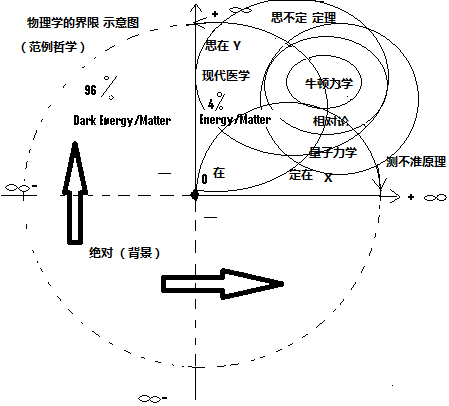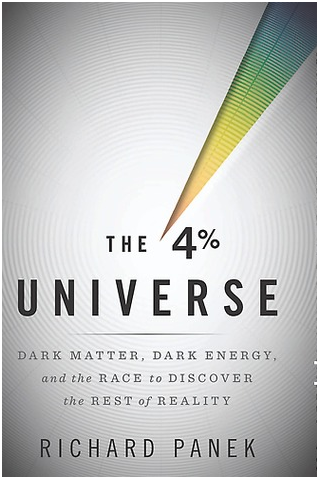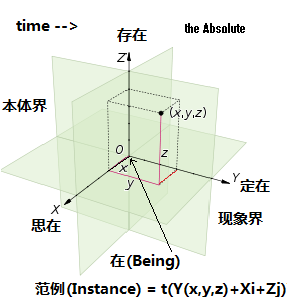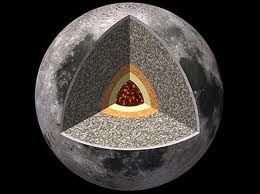范例哲学的人类科学知识界限(3) 在从上个世纪开始到现在的100多年以来,人类在科学知识的探索方面遇到了一个空
前的挑战。这个挑战,或者“撞墙”,使得科学技术几乎在原地踏步 - 科学家通常
称作:瓶颈。
这个挑战来自四个方面,它们分别是:1)量子力学和关于相对论的统一场论;2)量
子力学关于“测不准原理”的广泛共识的接受;3)人的意识与大脑思维的关系;4)和
当代天体物理学中宇宙中暗物质和暗能量的分布和探测。人类已经知道了宇宙中的
四种力的存在,如引力,电磁力,强相互作用力和弱相互作用力。以及前不久欧洲
原子能中心对撞机对波色子的发现 - 对早先预测的粒子存在,用于解释微观粒子如
何产生物质和弱相互作用力的一大空白填补。
严格地说,对人类理解自然界的探索中主要问题,后三者更为重要一些。因为量子
力学与广义相对论的统一,只是数学表达公式的精简与否的问题。真理是客观的,
并不依赖人类理解方法的变化而变化。如果各自独立的数学表达式已经代表了真理
的发现,精简表达式的统一场论,只能带来更完美的更华丽的外表,而且这一步的
发现只是时间问题。没有人类知识的根本“质变”,“量的增加”只能是锦上添花。
其他三种问题的性质,则复杂的多,而且涉及更深入的问题。也就是,当人类反复
求解这三个问题,反复证实这三个问题的真实性,人类是否应该继续延着过去的经
验路线,既,仍然认为是一定可以突破此瓶颈,而不需要跳出思维的局限,采取
“out of the box thinking”的思维方式。
比如关于“测不准原理”,通俗地说,当“盾"比“矛”还小时,很明显,矛和盾
的位置就变换了。原先的矛,永远也不可能刺进原先的盾了。所以科学探测仪器必
然要干扰微粒子的动量和位置了。同理也可以解释为什么大脑神经外科医学家,不
能探测到意识生成的规律,不可能从大束神经元的启动与点燃中,理解他们与人类
的意识的关系。既人的大脑是如何产生自我中心的意识,和进行思维如何可能的问
题。如果科学遇到障碍,因为自然科学的经验性质,哲学必须提供新的自己的解释。
既哲学应该从逻辑上指出科学探索道路的正确性与否,从而领导科学前进。
这就是范例哲学试图解决问题的方法 - 提供哲学的解释,启发科学家的研究深入。
范例哲学将量子物理学的粒子对象,和思维中的神经元运动,看成自然界存在的现
象。他们不是一般的现象,而是自然现象的最后堡垒,既,他们处在“自身形式”
的最后消失阶段。
范例哲学的本体论,将自然现象散布与存在的哲学概念中。具体地说,一切现象的
逻辑前提是“绝对”的背景。绝对是最根本的范畴,不容质疑。绝对就是中国传统
概念的“无”。从“无中生有”开始,第一个起点是“在”。用当代天体物理学的
看法,可以视在为“奇点”,这时一切都等于零。在奇点储蓄足够的暗能量和暗物
质之后,在的所维尺度中的一个 - 存在的范畴 - 就产生了。由于存在范畴内容的
空泛,存在与是不存在任何具体的内容,就是非存在。暗中的能量潜在的物质,与
存在的空虚性,导致了宇宙的大爆炸的开始。首先在爆炸中产生的是时间。由时间
产生空间和其他的限制性。这就是第二维,“定在”的开始。定在,是-存在的规定
性(多,数)由大到小,由固定到飘忽。最后产生思在- 作为思维的规定性(重构
现实,抽象掉时空,变成记忆(符号?)储存)具体到抽象,形象,符号,数字,
逻辑,理性,悟性等等。
所以说,范例哲学认为,面对这四大问题,人类也许遇到的不再是过去类型的瓶颈困
难,而是需要转换思维方式。下面这就是简要的范例哲学的本体论对这些科学问题的尝试
解释和图解。

能否用范例哲学的本体论的知识,尝试证明人类所知的物质和能量比例符合爱因斯坦的质能关系式:E=MC^2呢?我们知道人类所知到的物质和能量,仅仅占宇宙总能量和物质的百分之四左右,计算约是这样得来的,参见下面一书: 
"The 4 Percent Universe: Dark Matter, Dark Energy, and the Race to Discover the Rest of Reality by Richard Panek The epic, behind-the-scenes story of an astounding gap in our scientific knowledge of the cosmos.
In the past few years, a handful of scientists have been in a race to explain a disturbing aspect of our universe: only 4 percent of it consists of the matter that makes up you, me, our books, and every planet, star, and galaxy. The rest—96 percent of the universe—is complete.." 

The whole universe after the Big Bang and its 3 dimensions mentioned above 我们是否可以这样推测:如果以“绝对”的范例本体论背景下的“世界”,作为百分之百,而我们所知道的,现在居住的地球,和所属的所有星系算“一次大爆炸”后的结果,算作“1”。那么如果我要计算我们所知道的所有质量和物质的在定在,存在和思在范围内的比例,也就是相当于整个范例本体论所描述的“绝对世界”的几分之几,我们就按照简单平均一下三个维度。这三个维度所占的当在大于零时,相当于整个范例本体空间“1”的八分之一,也就是0.125.然后再简单平均一下三个维度所产生的“物质”,有理由相信,在宇宙中,物质(能量)的分布是大致均匀的。真正定在的物质和能量,才是我们可以计算的:0.125/3 = 0.041左右,也就是4.1%, 整个三维所占体积的三分之一为物质和能量的比例,大约符合天体物理学家算出得出大约4%的数据。是不是范例哲学有几分预测性,您自己判断。 ========================= Ref: Dark Energy, Dark Matter In the early 1990's, one thing was fairly certain about the expansion of the Universe. It might have enough energy density to stop its expansion and recollapse, it might have so little energy density that it would never stop expanding, but gravity was certain to slow the expansion as time went on. Granted, the slowing had not been observed, but, theoretically, the Universe had to slow. The Universe is full of matter and the attractive force of gravity pulls all matter together. Then came 1998 and the Hubble Space Telescope (HST) observations of very distant supernovae that showed that, a long time ago, the Universe was actually expanding more slowly than it is today. So the expansion of the Universe has not been slowing due to gravity, as everyone thought, it has been accelerating. No one expected this, no one knew how to explain it. But something was causing it. Eventually theorists came up with three sorts of explanations. Maybe it was a result of a long-discarded version of Einstein's theory of gravity, one that contained what was called a "cosmological constant." Maybe there was some strange kind of energy-fluid that filled space. Maybe there is something wrong with Einstein's theory of gravity and a new theory could include some kind of field that creates this cosmic acceleration. Theorists still don't know what the correct explanation is, but they have given the solution a name. It is called dark energy. What Is Dark Energy? 
Universe Dark Energy-1 Expanding Universe This diagram reveals changes in the rate of expansion since the universe's birth 15 billion years ago. The more shallow the curve, the faster the rate of expansion. The curve changes noticeably about 7.5 billion years ago, when objects in the universe began flying apart as a faster rate. Astronomers theorize that the faster expansion rate is due to a mysterious, dark force that is pulling galaxies apart. NASA/STSci/Ann Feild More is unknown than is known. We know how much dark energy there is because we know how it affects the Universe's expansion. Other than that, it is a complete mystery. But it is an important mystery. It turns out that roughly 70% of the Universe is dark energy. Dark matter makes up about 25%. The rest - everything on Earth, everything ever observed with all of our instruments, all normal matter - adds up to less than 5% of the Universe. Come to think of it, maybe it shouldn't be called "normal" matter at all, since it is such a small fraction of the Universe. One explanation for dark energy is that it is a property of space. Albert Einstein was the first person to realize that empty space is not nothing. Space has amazing properties, many of which are just beginning to be understood. The first property that Einstein discovered is that it is possible for more space to come into existence. Then one version of Einstein's gravity theory, the version that contains acosmological constant, makes a second prediction: "empty space" can possess its own energy. Because this energy is a property of space itself, it would not be diluted as space expands. As more space comes into existence, more of this energy-of-space would appear. As a result, this form of energy would cause the Universe to expand faster and faster. Unfortunately, no one understands why the cosmological constant should even be there, much less why it would have exactly the right value to cause the observed acceleration of the Universe. 
Dark Matter Core Defies Explanation This image shows the distribution of dark matter, galaxies, and hot gas in the core of the merging galaxy cluster Abell 520. The result could present a challenge to basic theories of dark matter. Another explanation for how space acquires energy comes from the quantum theory of matter. In this theory, "empty space" is actually full of temporary ("virtual") particles that continually form and then disappear. But when physicists tried to calculate how much energy this would give empty space, the answer came out wrong - wrong by a lot. The number came out 10120 times too big. That's a 1 with 120 zeros after it. It's hard to get an answer that bad. So the mystery continues. Another explanation for dark energy is that it is a new kind of dynamical energy fluid or field, something that fills all of space but something whose effect on the expansion of the Universe is the opposite of that of matter and normal energy. Some theorists have named this "quintessence," after the fifth element of the Greek philosophers. But, if quintessence is the answer, we still don't know what it is like, what it interacts with, or why it exists. So the mystery continues. A last possibility is that Einstein's theory of gravity is not correct. That would not only affect the expansion of the Universe, but it would also affect the way that normal matter in galaxies and clusters of galaxies behaved. This fact would provide a way to decide if the solution to the dark energy problem is a new gravity theory or not: we could observe how galaxies come together in clusters. But if it does turn out that a new theory of gravity is needed, what kind of theory would it be? How could it correctly describe the motion of the bodies in the Solar System, as Einstein's theory is known to do, and still give us the different prediction for the Universe that we need? There are candidate theories, but none are compelling. So the mystery continues. The thing that is needed to decide between dark energy possibilities - a property of space, a new dynamic fluid, or a new theory of gravity - is more data, better data. What Is Dark Matter? 
Abell 2744: Pandora's Cluster Revealed One of the most complicated and dramatic collisions between galaxy clusters ever seen is captured in this new composite image of Abell 2744. The blue shows a map of the total mass concentration (mostly dark matter). By fitting a theoretical model of the composition of the Universe to the combined set of cosmological observations, scientists have come up with the composition that we described above, ~70% dark energy, ~25% dark matter, ~5% normal matter. What is dark matter? We are much more certain what dark matter is not than we are what it is. First, it is dark, meaning that it is not in the form of stars and planets that we see. Observations show that there is far too little visible matter in the Universe to make up the 25% required by the observations. Second, it is not in the form of dark clouds of normal matter, matter made up of particles called baryons. We know this because we would be able to detect baryonic clouds by their absorption of radiation passing through them. Third, dark matter is not antimatter, because we do not see the unique gamma rays that are produced when antimatter annihilates with matter. Finally, we can rule out large galaxy-sized black holes on the basis of how many gravitational lenses we see. High concentrations of matter bend light passing near them from objects further away, but we do not see enough lensing events to suggest that such objects to make up the required 25% dark matter contribution. However, at this point, there are still a few dark matter possibilities that are viable. Baryonic matter could still make up the dark matter if it were all tied up in brown dwarfs or in small, dense chunks of heavy elements. These possibilities are known as massive compact halo objects, or "MACHOs". But the most common view is that dark matter is not baryonic at all, but that it is made up of other, more exotic particles like axions or WIMPS (Weakly Interacting Massive Particles). |
